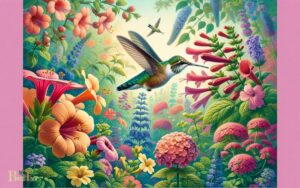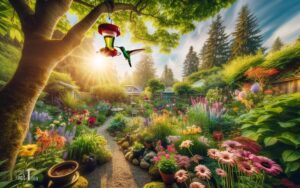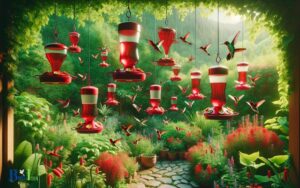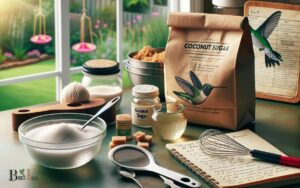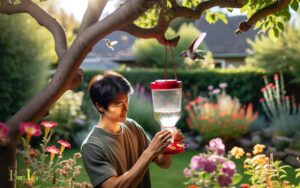How to Make Hummingbird Food? 4 Easy Steps!
Create homemade hummingbird food by mixing one part white granulated sugar with four parts water. Boil the solution for 1-2 minutes to ensure cleanliness, cool it, and then fill your feeders.
Quick Steps:
Here’s an example for a standard feeder:
- – 1/4 cup sugar
- – 1 cup water
Attract hummingbirds naturally with this simple, effective homemade nectar, free from dyes and additives.
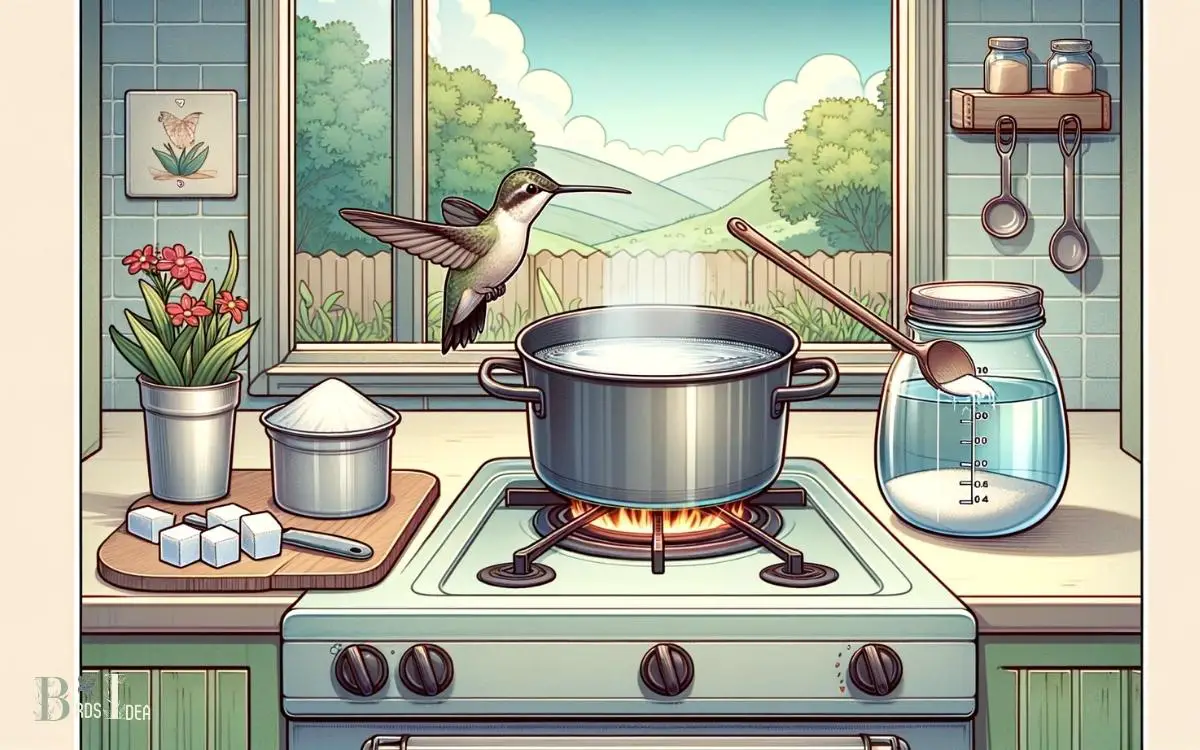
Key Takeaway
Ingredients Needed
To make hummingbird food, gather the following ingredients before proceeding with the preparation: white, granulated sugar and water.
It is crucial to use only white sugar, as other sweeteners like honey, brown sugar, or artificial sweeteners can be harmful to hummingbirds.
The ratio of sugar to water is essential for the well-being of the birds. The recommended ratio is 1 part sugar to 4 parts water.
The water should be boiled to remove impurities and then mixed with the sugar until it dissolves. Once these ingredients are gathered and prepared, the next step is to mix the nectar.
Step 1: Mixing the Nectar
When mixing the nectar for hummingbird food, it is crucial to maintain a specific sugar and water ratio to provide the necessary energy and hydration for the birds.
The recommended ratio is four parts water to one part granulated sugar.The mixture should be brought to a boil to ensure the sugar is fully dissolved and the water is purified.
Sugar and Water Ratio
The recommended sugar and water ratio for making hummingbird food is 1 part sugar to 4 parts water.
This ratio closely resembles the sucrose levels found in the nectar of many flowers that hummingbirds naturally feed on.
When preparing the nectar, it is important to use plain white granulated sugar as it most closely mirrors the natural sucrose content found in flowers.
Using alternative sweeteners such as honey, artificial sweeteners, or brown sugar is not recommended as these can be harmful to hummingbirds.
It is crucial to mix the sugar and water thoroughly until the sugar is completely dissolved. This ensures that the hummingbirds receive the necessary energy from the nectar.
Once the sugar and water are combined, the next step is to boil the mixture to effectively sterilize it.
Next, let’s discuss the process of boiling the mixture.
Boiling the Mixture
The first step in mixing the nectar for hummingbird food involves placing the sugar and water mixture in a saucepan over medium heat. It is crucial to ensure that the sugar completely dissolves in the water.
Stir the mixture continuously to facilitate the dissolving process and prevent the sugar from caramelizing at the bottom of the pan.
Once the sugar has completely dissolved, allow the mixture to come to a gentle boil. Boiling the mixture helps to sterilize the nectar, eliminating any impurities that may be present.
Let the mixture simmer for about 1-2 minutes, then remove it from the heat and allow it to cool completely before transferring it to the hummingbird feeder.
This boiling process ensures that the nectar is safe and ready to attract and nourish these delightful birds.
Step 2: Choosing the Right Feeder
To ensure the best feeding experience for hummingbirds, it is essential to select a feeder that provides easy access to the nectar and is easy to clean and maintain.
When choosing a feeder, consider the following:
Feeder Type:
- Opt for feeders with perches to allow hummingbirds to rest while feeding.
- Tube feeders with built-in bee guards can prevent insects from contaminating the nectar.
Material and Design:
- Choose feeders made of clear plastic or glass to easily monitor nectar levels and cleanliness.
- Look for feeders with wide openings to facilitate refilling and cleaning.
Selecting the right feeder plays a crucial role in attracting and providing a safe and convenient feeding environment for hummingbirds.
By considering feeder type, material, and design, you can ensure a delightful and sustainable feeding experience for these beautiful birds.
Step 3: Placing the Feeder
Placing the feeder in a strategic location ensures that hummingbirds have easy access to the nectar and can rest comfortably while feeding, enhancing their overall feeding experience.
To optimize the placement of the feeder, it should be positioned in a shaded area to prevent the nectar from spoiling too quickly in the sun.
It is important to place the feeder where it is visible, both to the hummingbirds and to those who enjoy watching them.
Ideally, the feeder should be near flowers or shrubs, as these provide natural perches and shelter for the birds. Placing the feeder near windows should be avoided, as the reflection can cause collisions.
Lastly, ensuring that the feeder is positioned at a height that is easily accessible for cleaning and refilling will contribute to the well-being of the hummingbirds.
Step 4: Maintaining the Feeder
To ensure the well-being of hummingbirds, it is crucial to maintain the feeder by regularly refilling the nectar to provide a consistent food source.
Cleaning the feeder thoroughly is essential to prevent the growth of mold and bacteria, which can be harmful to the hummingbirds.
By following these maintenance practices, the feeder can continue to provide a safe and reliable food source for these delicate birds.
Refilling the Nectar Regularly
Regularly refilling the nectar in the feeder is essential for maintaining a healthy and inviting environment for hummingbirds.
This practice ensures that the birds have a consistent food source and helps prevent the growth of mold or bacteria in the feeder.
To effectively maintain the feeder, consider the following:
Frequency
- Refill the feeder every 3 to 4 days, especially in warmer weather, to prevent the nectar from spoiling.
- Monitor the nectar levels daily, especially during peak hummingbird season, and refill as needed to ensure a continuous food supply.
Cleaning the Feeder Thoroughly
Periodically inspect and clean the feeder thoroughly to ensure the health and safety of the hummingbirds.
A clean feeder prevents the growth of mold and the transmission of diseases, ultimately contributing to the well-being of the hummingbirds.
Use a solution of one-part white vinegar to four parts water for cleaning, and ensure all parts of the feeder are thoroughly rinsed and dried before refilling with fresh nectar.
Here’s a table summarizing the cleaning process:
| Feeder Component | Cleaning Method | Frequency |
|---|---|---|
| Glass or Plastic | Wash with mild soap and a bottle brush | Every 1-2 weeks |
| Ports and Perches | Soak in vinegar solution and scrub with a small brush | Every 1-2 weeks |
| Hanging Hardware | Wipe down with a vinegar-soaked cloth | Every 2-4 weeks |
| Nectar Reservoir | Clean with a bottle brush and vinegar solution | Every 1-2 weeks |
Regular, thorough cleaning of the feeder components is essential for maintaining a healthy environment for the hummingbirds.
Tips for Attracting Hummingbirds
Attracting hummingbirds to your garden requires creating a welcoming environment with the right food, plants, and nesting areas.
To attract these delightful birds, consider the following tips:
Plant Selection
- Choose tubular flowers such as bee balm, trumpet vine, and columbine, which are rich in nectar and attract hummingbirds.
- Incorporate native plants as they provide familiar food sources and nesting materials.
Feeder Placement
- Position feeders near flowers and plants that hummingbirds are naturally attracted to.
- Ensure that the feeders are placed in shaded areas to prevent the nectar from spoiling too quickly.
Creating an ideal habitat with suitable plants and food sources can greatly increase the likelihood of attracting hummingbirds to your garden.
However, it’s important to be aware of potential issues and solutions in order to maintain a healthy environment for these birds.
Potential Issues and Solutions
To address potential issues and solutions in attracting hummingbirds to your garden, consider the impact of weather conditions on the availability and quality of nectar.
Weather fluctuations, such as extreme heat or cold, can affect the blooming and production of nectar-rich flowers, thereby impacting the food sources for hummingbirds.
Here’s a table outlining potential issues and their solutions:
| Potential Issues | Solutions |
|---|---|
| Nectar Freezing | Use insulated feeders to prevent freezing |
| Nectar Spoilage | Clean feeders regularly to prevent spoilage |
| Lack of Flower Blooms | Plant a variety of flowers for continuous nectar supply |
| Insect Infestation | Use natural pest control methods to deter insects |
Hummingbird Nectar Recipe Cane Sugar
Making hummingbird nectar at home is a simple process.
Here’s a basic recipe using cane sugar:
Ingredients:
- 1 cup cane sugar
- 4 cups water
Instructions:
- Start by bringing 4 cups of water to a boil. Boiling helps to remove impurities from the water and ensures a clean nectar for the hummingbirds.
- Once the water is boiling, add 1 cup of cane sugar to the hot water.
- Stir the sugar until it dissolves completely. This forms a clear sugar water solution.
- Allow the nectar to cool to room temperature. It’s important not to add hot nectar to your hummingbird feeder, as it may harm the birds.
- Once the nectar has cooled, you can fill your hummingbird feeder.
Remember to clean your hummingbird feeder regularly, ideally every few days, to prevent the growth of mold or bacteria. Also, if you have leftover nectar, you can store it in the refrigerator for up to one week.
Note: Do not use honey or artificial sweeteners in hummingbird nectar, as they can be harmful to the birds. Stick to plain cane sugar and water for their safety and well-being.
What Are the Steps to Make Hummingbird Food?
Looking to attract hummingbirds to your backyard? Follow this simple recipe for making hummingbird feed. Start by mixing one part white granulated sugar with four parts boiled water. Stir until the sugar is completely dissolved and let it cool. Fill your hummingbird feeder with the mixture, and remember to clean and refill it every few days to keep the birds coming back for more. Enjoy watching these delightful creatures sip on the homemade nectar!
How to Make 1 Cup of Hummingbird Food?
Making hummingbird food, also known as hummingbird nectar, is a simple process.
Here’s a basic recipe for making 1 cup of hummingbird food:
Ingredients:
- 1/4 cup granulated sugar
- 1 cup water
Instructions:
- Boil Water: Bring 1 cup of water to a boil. Boiling helps to dissolve the sugar and ensures that the water is free from impurities.
- Add Sugar: Once the water is boiling, add 1/4 cup of granulated sugar to the boiling water. Stir until the sugar is completely dissolved.
- Cool: Allow the sugar water to cool to room temperature. You can speed up this process by placing the container in the refrigerator.
- Fill Feeder: Once the sugar water has cooled, fill your hummingbird feeder with the nectar. Be sure not to overfill the feeder to avoid wastage.
- Hang the Feeder: Hang the filled hummingbird feeder in a location where hummingbirds are likely to find it. Ideally, it should be in a shaded area to prevent the nectar from spoiling too quickly.
- Maintain and Clean: Regularly clean the hummingbird feeder and replace the nectar every 3-5 days, or more frequently in hot weather, to prevent the growth of harmful molds and bacteria.
Important Tips:
- Do not use red food coloring: There is no need to add red food coloring to the hummingbird nectar. The red color of the feeder is sufficient to attract hummingbirds.
- Use plain white sugar: It’s recommended to use plain white granulated sugar for making hummingbird nectar. Do not use honey, brown sugar, or artificial sweeteners, as they can be harmful to hummingbirds.
- Boil the water: Boiling the water helps to remove impurities and ensures a clean nectar solution.
By following these simple steps and maintaining a clean feeder, you can provide a safe and attractive environment for hummingbirds to feed in your backyard.
Conclusion
Creating hummingbird food requires a simple mixture of sugar and water, the use of a suitable feeder, and strategic placement to attract these fascinating creatures.
By maintaining the feeder and implementing tips for attracting hummingbirds, individuals can enjoy the beauty and grace of these tiny birds in their own backyard.
However, it is important to be mindful of potential issues and solutions to ensure the well-being of the hummingbirds. Nature’s delicate balance is in our hands.

